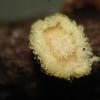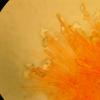
24-12-2025 17:08
Hulda Caroline HolteHello, I have found this propoloid ascomycete on

21-12-2025 09:32
Hello.A tiny ascomycete found embedded in wood in

21-12-2025 21:32
Pol DebaenstHello, Garden, Burgweg 19, Veurne, BelgiumOn 10/1

22-12-2025 23:38
Patrice TANCHAUDBonsoir, récolte sur un mur en pierre, apothéci

22-12-2025 00:47
Patrice TANCHAUDBonsoir, récolte à proximité du milieu dunaire
"Le Gal (1939) described this form as D. morthieri (Cooke) Sacc., recorded it on Eupatorium (?) and Mentha silvestris but added that 'elle semblait n'être qu'une forme grêle de' D. nudipes. No Dasyscypha remains on Cooke's specimen of Peziza morthieri but his accompanying sketches show short cylindrical hairs bearing a large apical crystal mass and filiform paraphyses not exceeding the asci. A sketch of two cup-shaped apothecia is labelled "sulphur colour'. The collector's note reads 'Peziza ad caules Senecionis'. This is clearly not the fungus of Le Gal."
Wouldn't Lachnum nudipes var. minor Dennis be a better name for this taxon?
Thanks for any help, may be I have missed some more recent reference.
Eduard

indeed L. morthieri is a doubtful taxon. But I think that L. nudipes var. minor has never been reexamined from the type. I wonder whether it has croziers or not. L. nudipes is with croziers and a species that also grows on Filipendula and which I called "subnudipes" has much smaller spores and inamyloid asci without croziers. But I fear there exist more species. What I identified in 1976 as morthieri is such a third species, but I never clarified the croziers situation.
Did you document any collection?
Zotto
Thank you for your prompt reaction and comments. I have contacted the person who made the collection for further details and I will come back on this shortly.
Eduard
Ascomata 0,5 – 0,6 mm Ø, stipe 0,2 mm, hymenium and hairs pale yellow. Hairs 60-70 x 4-5 mu, encrusted, with single, striking large crystal on top (10-13 mu). Paraphyses beyond asci, lanceolate, width 5-6 mu. Spores (6-) 8-10 x2 mu, sometimes slightly curved, oil 1. Asci 40-50 mu, croziers not checked. Growing on herbaceous stem or twig.

Sp. 6-11/1,2-1,5 µm, oil content 1, A. 40-50 µm long, Ap. 0,8-1 mm, stipe 0,3-0,5 mm
............................................................................................................... L. morthieri
Sp. 9-15/1,7-2,3 µm, oil content 0, A. 65-80 µm long, Ap. 0,7-2,2 mm, stipe 1-2,5 mm ............................................................................................................... L. nudipes
The material was collected in a regenerating peat bog area where the occurrence of Filipendula is unlikely, so this substrate can be excluded.
Eduard


